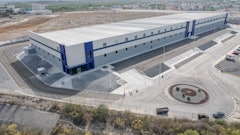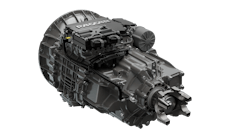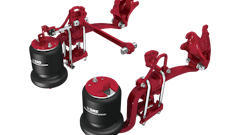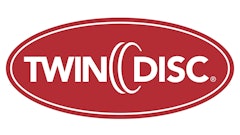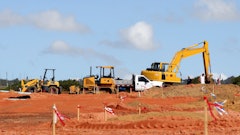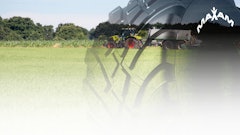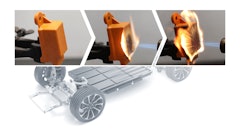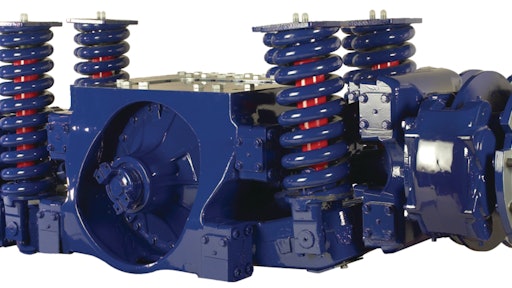
On rugged construction sites off-road trucks usually cannot drive at their maximum speeds because drivers are exposed to excessive shock and vibration, what occupational safety experts call whole body vibration (WBV): lateral and vertical forces that jostle drivers as the vehicle bounces over the terrain.
Tier One supplier Timoney Technology has designed independent suspension that enables trucks to travel at higher speeds without exceeding standards for driver vibration exposure. Timoney's suspension concept reportedly boosts the productivity of off-highway trucks by as much as 50%.
Timoney's engineers use LMS Virtual.Lab Motion multibody simulation to "drive" models over virtual terrain and determine ride and handling behavior early in development. They accurately predict loads and vibration throughout the vehicle, find the root cause of problems, and tune the suspension for a smoother ride on uneven surfaces.
WBV is not only uncomfortable, but has serious work-related health risks. It contributes to an injury rate that authorities say is 40% higher for construction workers than private industry as a whole. A European Community directive mandates that the overall vibration dose to an operator cannot exceed a given level for an eight-hour day. The Human Vibration Directive 2002/44/EC that took effect in 2005 established single-action limits of 0.5 m/s2 and absolute limits of 1.15 m/s2. Levels of driver acceleration and ride indices are also defined by ISO 2631.
By decoupling the effect of asymmetrical wheel loading, the Timoney double-wishbone independent suspension reduces the driver's upper-body lateral acceleration and vertical acceleration at the seat.
"Smoothing the ride allows vehicles to negotiate rough terrain while maintaining traction on all wheels at speeds two to three times faster than those achieved with conventional beam-axle systems," says Timoney CEO, Shane O'Neill.
Based in Ireland, Timoney developed an independent suspension for airport rescue trucks in the 1970s. Emergency vehicles have remained a major business segment for Timoney. It has also worked with independent suspensions for construction vehicles.
Timoney's engineers have become adept at developing independent suspensions for smoothing the ride of articulated dump trucks (ADTs), a hauler particularly susceptible to WBV because they operate in terrain that would stop conventional dump trucks.
A significant portion of its business comes from ADTs. "Leveraging these market opportunities requires the ability to develop suspensions for some of the most complex haulers in the world," O'Neill says.
Because most of Timoney's independent suspensions for ADTs are custom-engineered for each vehicle, LMS Virtual.Lab Motion is an important tool.
Engineering Director John Nolan says the tool predicts vibration over various terrain as well as the dynamic behavior of full vehicles for J-turns and other maneuvers. "The software accurately determines critical loads, accelerations and motion paths of components in the form of quantitative plots, as well as animations that provide valuable insight into the overall dynamic behavior of the vehicle and suspension.
"Making the necessary trade-off decisions between ride, handling, packaging and cost in a timely manner for such complex designs is no easy task for ADTs," he says. "By utilizing LMS Virtual.Lab Motion, we can account for all these factors, performing cross-attribute optimizations and assessing multiple design alternatives with fast iterative simulations that predict dynamic motion and internal loads. The software is ideally suited to address the many complex issues of reducing WBV in construction equipment."
In a recent project, Engineering Designer and Analyst Shaun McFadden used the software in developing an independent double-wishbone suspension to replace a leading-arm suspension for a 30-ton ADT.
An LMS Virtual.Lab model was created to represent the existing hauler. The simulation model was then "driven" over virtual surfaces at various speeds with the software calculating driver accelerations defined by ISO 2631. Validation features that compare the simulation with physical test results enabled McFadden to verify that the virtual model accurately predicted real-world accelerations experienced by the driver.
"The ability of LMS Virtual.Lab Motion to present output data in so many ways — particularly animations — was valuable for us in understanding the behavior of the original truck design and in identifying the root cause of vibration," McFadden says. "The leading-arm beam axle suspension had high roll stiffness, which caused large lateral accelerations on the driver seated high up in the vehicle."
To provide more compliance in the roll direction and effectively isolate the vehicle from ground forces, the leading-arm suspension was replaced with an independent double-wishbone suspension in the virtual vehicle model and the simulation was reran to determine the maximum travel speed.
Several design iterations were required to explore various alternatives for spring and damper size and stiffness until maximum performance was achieved.
Based on the increase in maximum allowable speed determined with the software, the productivity of the ADT with the Timoney independent suspension was shown to increase as much as 50% overall across the three types of applications in round-trip haul cycles — a productivity gain that outweighs the slightly higher cost of the independent suspension.
"Throughout the process of developing the suspension, LMS Virtual.Lab Motion was indispensable in pinpointing the root cause of vibration problems in the old suspension and in quickly guiding us toward the best design for the new independent suspension," says McFadden. "Animations in particular were a powerful means of visually demonstrating the performance improvement of the new versus old suspension and in providing convincing proof of a significant productivity increase."






